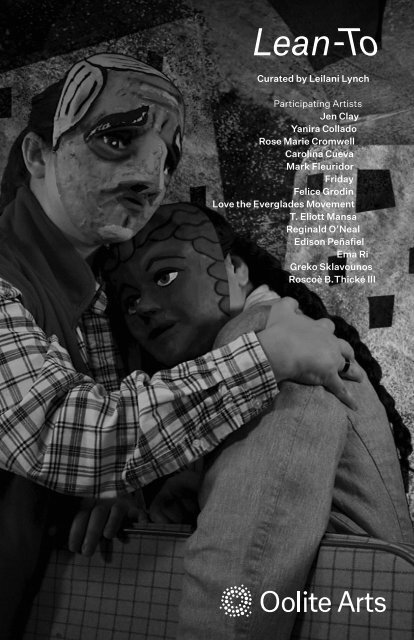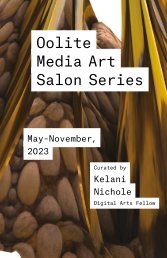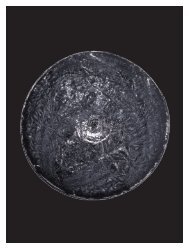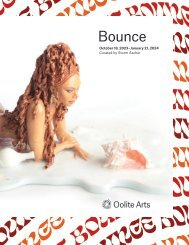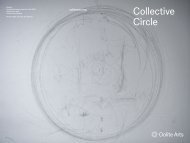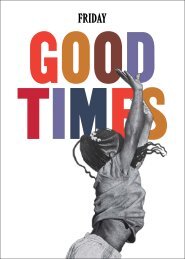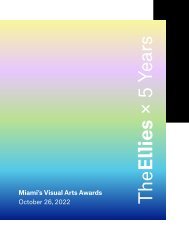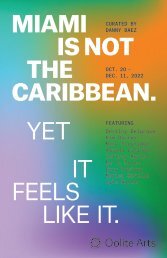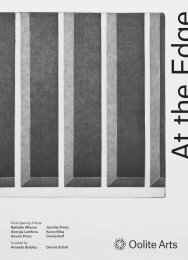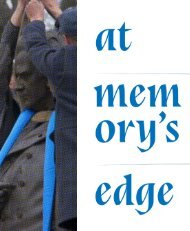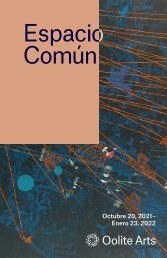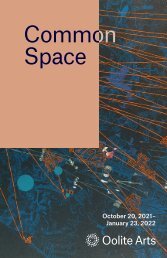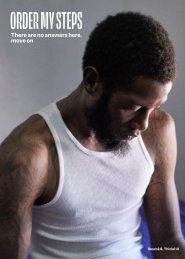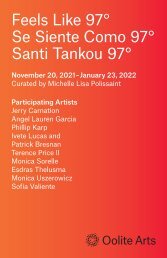Lean-To
Create successful ePaper yourself
Turn your PDF publications into a flip-book with our unique Google optimized e-Paper software.
Curated by Leilani Lynch<br />
Participating Artists<br />
Jen Clay<br />
Yanira Collado<br />
Rose Marie Cromwell<br />
Carolina Cueva<br />
Mark Fleuridor<br />
Friday<br />
Felice Grodin<br />
Love the Everglades Movement<br />
T. Eliott Mansa<br />
Reginald O’Neal<br />
Edison Peñafiel<br />
Ema Ri<br />
Greko Sklavounos<br />
Roscoè B. Thické III
Yanira Collado, Untitled, 2021. Oil pastel, textile,<br />
house paint, carbon paper, wood, drywall. Courtesy<br />
of Emerson Dorsch, Photo by Francesco Casale.
Curated by Leilani Lynch<br />
June 8 – September 11, 2022<br />
<strong>Lean</strong>-to, an exhibition by Oolite’s 2022<br />
artists-in-residence, shows how their<br />
manifold practices probe and reimagine<br />
systems of support, preservation,<br />
and care. Inspired by the architectural<br />
notion of a lean-to — a temporary,<br />
often improvised shelter — the exhibiting<br />
artists offer opportunities for<br />
respite and space for reflection on<br />
supportive structures ranging from<br />
the spiritual, communal, and ancestral<br />
to the environmental and economical.<br />
Using varying media and personal<br />
entry points, many works examine how<br />
these structures manifest across time<br />
and space. Others embody the directionality<br />
of the exhibition title, <strong>Lean</strong>-to,<br />
and operate within the realm of<br />
speculation, proposing how we might<br />
contend with the yet-to-come.<br />
Visitors are free to navigate the exhibition<br />
via thematic trails that unfold<br />
from Oolite’s downstairs vitrine into<br />
the hallway and gallery spaces.<br />
• Holding Patterns<br />
Some artists in the exhibition reflect<br />
on personal and communal systems<br />
of remembering and preservation,<br />
along with the tensions inherent to<br />
acts of keeping and holding documents,<br />
objects, and people. Friday’s<br />
Supplement Archive (2019 – present)<br />
addresses the lack of Black culture<br />
and life preserved within institutional<br />
archives by creating a supplemental<br />
lexicon of Black iconography from<br />
painted and fired clay. This archive of<br />
meaningful cultural symbols ranges<br />
from everyday foods — like red<br />
beans and rice, and quarter juice<br />
bottles — to familiar home remedies<br />
and hair products. Shown<br />
within the vitrine, the grouping<br />
of works evokes contentious<br />
histories of museological and<br />
ethnographic display of BIPOC<br />
communities. Yanira Collado’s<br />
Untitled (2022) is a freestanding<br />
sculpture and appropriated architecture<br />
that explores how histories<br />
are captured and held within materials,<br />
and how they, in turn, may be<br />
assembled and melded to tell new<br />
stories and illuminate obscured narratives.<br />
The work is experienced by<br />
moving around and between two walllike<br />
structures (taken from a recent<br />
gallery show), making it both revelatory<br />
and protective. Using construction<br />
materials (drywall, wood) and<br />
drawings on carbon paper, the work<br />
carries the architectural memory of<br />
its past location within its construction.<br />
Reginald O’Neal’s house-like<br />
installation 18 years and counting<br />
(2022) embodies the keeping/<br />
holding dichotomy through a<br />
personal reflection on effects of<br />
the carceral system on families<br />
and significant others on the<br />
outside. The work is a monument<br />
to the realities of growing<br />
up with a loved one behind bars.<br />
Visitors walk into a spare, domestic<br />
setting where they find a portrait<br />
of the artist’s father (currently incarcerated)<br />
and are surrounded by audio<br />
conversations between his family and<br />
his father. Inspired by a similar desire
to celebrate and memorialize the<br />
artist’s community of family and loved<br />
ones, Mark Fleuridor’s Enveloped by<br />
the Sun #9 (Destiny) (2021) images<br />
the artist’s partner through a collage of<br />
screen-printed flora, photography, and<br />
acrylic paint. Fleuridor has described<br />
works in this series as portraits protected<br />
within environments of local<br />
foliage, in this case oranges, from his<br />
memories of growing up in Miami. In<br />
an act of intergenerational collaboration,<br />
Greko Sklavounos uses source<br />
material from his grandfather’s wrestling<br />
magazine, Lucha Libre, Mexico’s<br />
first periodical dedicated to the sport, 1<br />
to investigate both familial legacies<br />
of creativity and the power of print<br />
publications in constructing symbols<br />
of national identity. In Lucha Libre (I)<br />
(2022), Sklavounos activates images<br />
from his grandfather’s magazines,<br />
transforming pages into a painting<br />
language, and engages with ideas of<br />
framing, reproduction, and physicality<br />
through depictions of the body and<br />
manipulation of the work’s surface<br />
(ripping, skewing, folding).<br />
• Wayfinding<br />
Through the<br />
Unknown<br />
Other artists relate to the directionality<br />
implied in the exhibition’s<br />
title through speculative practices,<br />
connecting to ancestral cosmologies,<br />
collaborating with Artificial<br />
Intelligence, and offering resources<br />
towards caring for an ailing ecosystem.<br />
Felice Grodin’s NST_postcards [2522]<br />
(2022) is a video work that illustrates<br />
the neural style transfer process<br />
of combining and generating new<br />
Rose Marie Cromwell, Precipice, 2022.<br />
96 × 84 in., silk. Courtesy of the artist<br />
images. Using Google Co-Lab, an opensource<br />
platform, Grodin inputs a “content<br />
image” — ubiquitous landscapes<br />
of Miami coastline and waterways —<br />
with a “style reference” — Grodin’s own<br />
abstract, digitally rendered works —<br />
forming an algorithmically generated<br />
“painting” of Miami rendered in the<br />
artist’s style. These speculative postcards<br />
unfold in the looped video,<br />
positing a near-future where nature,<br />
humans, and AI may collaborate.<br />
Rose Marie Cromwell’s Feminist<br />
Landscapes series (2022) uses photography<br />
to capture scenes from the<br />
American West (abandoned mines,<br />
lean-tos, construction material), recalling<br />
childhood road trips through the<br />
region while reflecting on extraction<br />
and environmental degradation, and<br />
the role of maternal care and responsibility<br />
within both personal and societal<br />
contexts. Through a knowledgesharing<br />
“resource cart” Return <strong>To</strong><br />
Sender (2022), Love the Everglades<br />
Movement brings their environmental<br />
and social advocacy practice to<br />
an art context. The organization,<br />
collaboratively run by Rev. Houston<br />
Cypress and Jean Sarmiento, aims to
“implement evolving strategies across<br />
the full spectrum of being which address<br />
the environmental, structural, cultural,<br />
and spiritual problems plaguing<br />
the Florida Everglades by raising<br />
awareness and organizing positive<br />
community engagement at the<br />
local, regional, national, and global<br />
levels.” 2 Their installation offers<br />
resources to support and promote<br />
community engagement<br />
through literature, native plants,<br />
and audiovisual elements related<br />
to the Florida Everglades that<br />
meld scientific and indigenous<br />
knowledges.<br />
Drawing from lived experiences<br />
of loss, recovery and integration,<br />
Carolina Cueva’s sculpture reinterprets<br />
symbols and forms from Andean<br />
cosmology in an act of healing and<br />
communing with her indigenous roots.<br />
Her sculpture’s stepped shape references<br />
the Chakana cross, which is both<br />
a spiritual symbol and “wayfinding” tool<br />
that illustrates the cardinal directions<br />
and levels of existence (sky, earth,<br />
and underworld, with a circle as a<br />
unifying portal between). For Cueva,<br />
the work embodies a journey toward<br />
wholeness, evoking energies that<br />
allow for ritual and space to<br />
reunite fragmented parts of<br />
oneself. T. Eliott Mansa’s Mûntu<br />
mu mèso kaka kafwanga /only in<br />
our eyes does a person ever die.<br />
(2022) is a talismanic work that<br />
oscillates between memorial site,<br />
power object, cartography, and<br />
abstract configuration. Encrusting<br />
found material of varying cultural<br />
significance — broken plates, clusters<br />
of nails, stuffed teddy bears, shells<br />
— into a monochromatic formation,<br />
Mansa enacts a form of rasanblaj,<br />
a term coined by Dr. Gina Athena<br />
Ulysse, which reimagines the artistic<br />
practice of assemblage to encompass<br />
“assembly, compilation, enlisting,<br />
regrouping (of people, spirits, things,<br />
ideas).” 3<br />
• Material Embrace<br />
These last artists utilize the materiality<br />
of their works to give language to often<br />
intangible notions of care, anxiety,<br />
and healing. Through material exploration,<br />
they construct or reflect on<br />
protective structures, both seen and<br />
unseen. Jen Clay utilizes the warmth<br />
and comfort evoked by quilts to create<br />
There’s an alien living inside me<br />
(2022). This textile work has anthropomorphic<br />
elements with womb-like<br />
comparments and embroidered hands<br />
dangling across its brightly colored<br />
Jen Clay, DETAIL: Theres an alien living<br />
inside me, 2022, Courtesy of the artist<br />
1 The magazine produced more than 1300 issues<br />
between 1963 – 1990.<br />
2 Love The Everglades Movement, Mission<br />
Statement, http://www.lovetheeverglades.org/<br />
about-us.html.<br />
3 From Gina Athena Ulysse, “Avant-Garde Rasanblaj<br />
(A Meditation on PÒTOPRENS): The Black aesthetics<br />
of the first Black Republic,” Pioneer Works<br />
Broadcast (March 22, 2022), https://pioneerworks.<br />
org/broadcast/gina-athena-ulysse-potoprens.
surface. Clay externalizes feelings of<br />
discomfort — anxiety, fear, uncertainty<br />
— through a time-intensive sewing<br />
and dyeing process, transforming<br />
her materials through an uncanny<br />
yet tender embrace. Engaging the<br />
senses of sight touch and smell, Ema<br />
Ri’s Here with You (2022) comprises<br />
an accumulation of flower petals<br />
(harvested and dried by the artist)<br />
that serves as a vessel to reconnect<br />
viewers with their bodies. The<br />
sensorial installation aims to tether<br />
the dissociated mind, grounding<br />
viewers in their physicality and the<br />
present moment. Conversely, Edison<br />
Peñafiel’s The Farewell (2022) uses<br />
a repetitive filmic structure to intensify<br />
the emotions experienced by the<br />
characters in his videos. The work shows<br />
the final embrace before a loved one<br />
departs on a migratory journey, encapsulating<br />
sadness, anticipation, and fear<br />
in looped segments. Roscoè B. Thické’s<br />
photographic work Shifting Arrangements<br />
(2022) alludes to the fluid nature of<br />
familial structures and intergenerational<br />
relationships, particularly within<br />
the Pork ’n’ Beans housing project in<br />
Liberty City where the artist grew up.<br />
The intimately scaled diptych subtly<br />
shifts focus from child to elder, elder<br />
to child, reflecting on how traditional<br />
caregiving roles change over time.<br />
As another type of lean-to, it is apt<br />
to reflect on the nature of a residency<br />
like Oolite as a temporary<br />
shelter for artistic practice where<br />
individuals develop their art within<br />
the residency’s walls for a fixed<br />
period of time. This exhibition is<br />
testament to the creativity and community<br />
incubated within the artists’<br />
temporary studios, sprouting forth<br />
before eventually moving on.<br />
Roscoè B. Thické III, Shifting Arrangements I and II,<br />
2021, Courtesy of the artist
Ema Ri, DETAIL: Here With You, 2022, Courtesy of the artist and Spinello Projects
924 Lincoln Road<br />
Miami Beach, FL 33139<br />
Tag us: @OoliteArts • #OoliteArts<br />
OoliteArts.org<br />
Staff<br />
Dennis Scholl<br />
President and CEO<br />
Anais Alvarez<br />
Communications & Development Sr. Manager<br />
Danielle Bender<br />
Cinematic Arts Manager<br />
Amanda Bradley<br />
Programming Sr. Manager<br />
David Correa<br />
Programs Coordinator<br />
Cherese Crockett<br />
Development Sr. Manager<br />
Maylin Enamorado-Pinheiro<br />
Digital Communications Coordinator<br />
Aaron Feinberg<br />
Chief Financial Officer<br />
Melissa Gabriel<br />
Art Classes Manager<br />
Samantha Ganter<br />
Programs Coordinator<br />
Juan Matos<br />
Digital Content Producer & Coordinator<br />
Esther Park<br />
Vice President of Programming<br />
Dan Weitendorf<br />
Facilities Manager
Board of Directors<br />
Eric Rodriguez<br />
Chair<br />
Marie Elena Angulo<br />
Vice Chair<br />
Donnamarie Baptiste<br />
Secretary<br />
Kim Kovel<br />
Chair Emeritus<br />
Chloe Berkowitz<br />
Alessandro Ferretti<br />
Lilia Garcia<br />
Jane Goodman<br />
Adler Guerrier<br />
Thomas F. Knapp<br />
Jeff Krinsky<br />
Lin Lougheed<br />
Maricarmen Martinez<br />
Reagan Pace<br />
Deborah Slott<br />
Copy Editor<br />
John Ewing<br />
Translation<br />
Sergio Doré<br />
Exhibitions and programs at Oolite Arts are made possible with support from the Miami-Dade County<br />
Department of Cultural Affairs, the Cultural Affairs Council, the Miami-Dade Mayor and Board of County<br />
Commissioners; the City of Miami Beach Cultural Arts Council; the Miami Beach Mayor and City<br />
Commissioners; the State of Florida, Florida Department of State, Division of Arts & Culture, the Florida<br />
Arts Council; the National Endowment for the Arts; the Lynn & Louis Wolfson II Family Foundation, The<br />
Jorge M. Pérez Family Foundation at The Miami Foundation; the Al & Jane Nahmad Family Foundation;<br />
and the John S. and James L. Knight Foundation. Additional support provided by Walgreens Company.
Yanira Collado, Sin título, 2021. Pastel al óleo, textil,<br />
pintura de casa, carbón en papel, madera, yeso.<br />
Cortesía de Emerson Dorsch, Foto de Francesco Casale.
Organizado por Leilani Lynch<br />
Junio 8 - Septiembre 11, 2022<br />
<strong>Lean</strong>-to, una exposición de artistas<br />
residentes de Oolite del 2022, muestra<br />
cómo sus múltiples prácticas<br />
exploran y reimaginan los sistemas<br />
de apoyo, conservación y cuidado.<br />
Inspirados en la noción arquitectónica<br />
del lean-to — un refugio temporal y a<br />
menudo improvisado — , los artistas<br />
que exponen ofrecen oportunidades<br />
de descanso y espacio para la reflexión<br />
basadas en estructuras de apoyo<br />
que van desde lo espiritual, lo comunitario<br />
y lo ancestral hasta lo medioambiental<br />
y lo económico. Utilizando<br />
diversos medios y puntos de entrada<br />
personales, muchas obras examinan<br />
cómo se manifiestan estas estructuras<br />
en el tiempo y el espacio. Otras<br />
encarnan la direccionalidad del título<br />
de la exposición, <strong>Lean</strong>-to, y operan en<br />
el ámbito de la especulación, proponiendo<br />
cómo podríamos enfrentarnos<br />
a lo que está por venir.<br />
Los visitantes pueden recorrer libremente<br />
la exposición a través de<br />
senderos temáticos que se despliegan<br />
desde la vitrina de la planta baja de<br />
Oolite hasta el pasillo y los espacios de<br />
la galería.<br />
• Patrones de<br />
sujeción<br />
Algunos artistas de la exposición<br />
reflexionan sobre los sistemas personales<br />
y comunitarios de recuerdo y<br />
conservación, junto con las tensiones<br />
inherentes a los actos de guardar<br />
y conservar documentos, objetos y<br />
personas. Friday’s Supplement<br />
Archive (2019 – presente) aborda<br />
la falta de cultura y vida negra<br />
preservada dentro de los archivos<br />
institucionales mediante<br />
la creación de un léxico suplementario<br />
de iconografía negra<br />
a partir de arcilla pintada y<br />
cocida. Este archivo de símbolos<br />
culturales significativos<br />
abarca desde alimentos cotidianos<br />
— como judías rojas y arroz,<br />
y botellas de jugo de un cuarto —<br />
hasta remedios caseros familiares<br />
y productos para el cabello. En la<br />
vitrina, la agrupación de obras evoca<br />
historias polémicas de la exhibición<br />
museológica y etnográfica de las<br />
comunidades BIPOC. Sin título (2022),<br />
de Yanira Collado, es una escultura<br />
independiente y una arquitectura<br />
apropiada que explora cómo las historias<br />
se captan y se mantienen dentro<br />
de los materiales, y cómo éstos,<br />
a su vez, pueden ensamblarse y<br />
fundirse para contar nuevas historias<br />
e iluminar relatos oscuros. La<br />
obra se experimenta moviéndose<br />
alrededor y entre dos estructuras<br />
en forma de muro (tomadas<br />
de una reciente exposición<br />
de una galería), lo que la hace<br />
a la vez reveladora y protectora.<br />
Utilizando materiales de<br />
construcción (paneles de yeso,<br />
madera) y dibujos en papel carbón,<br />
la obra lleva la memoria arquitectónica<br />
de su ubicación anterior<br />
dentro de su construcción. La instalación<br />
18 years and counting (2022)
de Reginald O’Neal, con apariencia de<br />
casa, encarna la dicotomía guardar/<br />
conservar a través de una reflexión<br />
personal sobre los efectos del sistema<br />
carcelario en las familias y en los seres<br />
queridos en el exterior. La obra es un<br />
monumento a la realidad de crecer<br />
con un ser querido entre rejas. Los<br />
visitantes entran en un sobrio entorno<br />
doméstico en el que encuentran un<br />
retrato del padre del artista (actualmente<br />
encarcelado) y son rodeados<br />
por conversaciones en audio entre su<br />
familia y su padre. <strong>To</strong>do inspirado por<br />
un deseo similar de celebrar y conmemorar<br />
la comunidad de familiares<br />
y seres queridos del artista, Enveloped<br />
by the Sun #9 (Destiny) (2021), de<br />
Mark Fleuridor, representa a la pareja<br />
del artista a través de un collage de<br />
flora serigrafiada, fotografía y pintura<br />
acrílica. Fleuridor describe las obras<br />
de esta serie como retratos protegidos<br />
dentro de entornos de follaje local —<br />
en este caso naranjas — de sus recuerdos<br />
de crecimiento en Miami. En un<br />
acto de colaboración intergeneracional,<br />
Greko Sklavounos utiliza material<br />
original de la revista Lucha Libre<br />
— la primera publicación periódica<br />
de México dedicada a este deporte 1<br />
— de su abuelo, para investigar tanto<br />
los legados familiares de creatividad<br />
como el poder de las publicaciones<br />
impresas en la construcción de símbolos<br />
de identidad nacional. En Lucha<br />
Libre (I) (2022), Sklavounos activa las<br />
imágenes de las revistas de su abuelo<br />
transformando las páginas en un lenguaje<br />
pictórico y aborda las ideas de<br />
encuadre, reproducción y aspecto<br />
físico a través de las representaciones<br />
del cuerpo y la manipulación de la<br />
superficie de la obra (rasgado, sesgado,<br />
plegado).<br />
Rose Marie Cromwell, Precipice, 2022, 96 x 84<br />
pulgadas, seda. Cortesía de la artista.<br />
• Cómo encontrar el<br />
camino a través<br />
de lo desconocido<br />
Otros artistas se relacionan con la<br />
direccionalidad implícita en el título<br />
de la exposición a través de prácticas<br />
especulativas, conectándose con cosmologías<br />
ancestrales, colaborando<br />
con la Inteligencia Artificial y ofreciendo<br />
recursos para el cuidado de un<br />
ecosistema enfermo. NST_postcards<br />
[2522] (2022) de Felice Grodin es una<br />
obra en video que ilustra el proceso<br />
de transferencia de estilo neuronal<br />
de combinar y generar nuevas imágenes.<br />
Utilizando Google Co-Lab, una<br />
plataforma de código abierto, Grodin<br />
introduce una “imagen de contenido”<br />
(paisajes omnipresentes de la costa<br />
y las vías fluviales de Miami) con<br />
una “referencia de estilo” (las propias<br />
obras abstractas de Grodin renderizadas<br />
digitalmente) formando una<br />
“pintura” de Miami generada algorítmicamente<br />
y renderizada con el estilo<br />
de la artista. Estas postales especulativas<br />
se despliegan en el vídeo sinfín,<br />
planteando un futuro cercano en el
que la naturaleza, los humanos y la IA<br />
pueden colaborar. La serie Feminist<br />
Landscapes (2022) de Rose Marie<br />
Cromwell utiliza la fotografía para<br />
captar escenas del Oeste americano<br />
(minas abandonadas, cabañas,<br />
material de construcción), recordando<br />
los viajes por carretera de<br />
la infancia a través de la región,<br />
al tiempo que reflexiona sobre<br />
la extracción y la degradación<br />
del medio ambiente, y el papel<br />
del cuidado y la responsabilidad<br />
materna en contextos tanto personales<br />
como sociales. A través<br />
de un “carro de recursos” para<br />
compartir conocimientos Return to<br />
Sender (2022), Love the Everglades<br />
Movement traslada su práctica de<br />
defensa medioambiental y social<br />
a un contexto artístico. La organización,<br />
dirigida en colaboración por<br />
el reverendo Houston Cypress y Jean<br />
Sarmiento, tiene como objetivo “poner<br />
en práctica estrategias evolutivas en<br />
todo el espectro del ser que aborden los<br />
problemas medioambientales, estructurales,<br />
culturales y espirituales que<br />
asolan los Everglades de Florida mediante<br />
la concientización y la organización<br />
de un compromiso comunitario<br />
positivo a nivel local, regional,<br />
nacional y mundial”. 2<br />
Su instalación ofrece recursos<br />
para apoyar y promover el compromiso<br />
de la comunidad a través<br />
de literatura, plantas autóctonas<br />
y elementos audiovisuales relacionados<br />
con los Everglades de<br />
Florida que fusionan conocimientos<br />
científicos e indígenas.<br />
1 La revista publicó más de 1300 ediciones entre<br />
1963 – 1990.<br />
2 Love The Everglades Movement, Declaración<br />
de Misión, http://www.lovetheeverglades.org/<br />
about-us.html.<br />
A partir de experiencias vividas de<br />
pérdida, recuperación e integración,<br />
la escultura de Carolina Cueva reinterpreta<br />
símbolos y formas de la cosmología<br />
andina en un acto de curación<br />
y comunión con sus raíces indígenas.<br />
La forma escalonada de su escultura<br />
hace referencia a la cruz chakana, que<br />
es tanto un símbolo espiritual como<br />
una herramienta de “orientación” que<br />
ilustra los puntos cardinales y los niveles<br />
de la existencia (cielo, tierra e inframundo,<br />
con un círculo como portal<br />
unificador entre ellos). Para Cuevas,<br />
la obra encarna un viaje hacia la plenitud,<br />
evocando energías que permiten<br />
el ritual y el espacio para reunir las<br />
partes fragmentadas de uno mismo.<br />
Mûntu mu mèso kaka kafwanga / only<br />
in your eyes does a person ever die de<br />
T. Eliott Mansa (2022) es una obra talismán<br />
que oscila entre sitio conmemorativo,<br />
objeto de poder, cartografía y<br />
configuración abstracta. Incrustando<br />
materiales encontrados de diverso significado<br />
cultural — platos rotos, grupos<br />
de clavos, osos de peluche, conchas—<br />
en una formación monocromática,<br />
Jen Clay, DETAIL: There’s an alien living inside<br />
of me, 2022, Cortesía de la artista.<br />
3 De Gina Athena Ulysse, “Avant-Garde<br />
Rasanblaj (A Meditation on PÒTOPRENS): La<br />
estética negra de la primera república negra”,<br />
Emisión de Obras Pioneras (22 de marzo de<br />
2022), https://pioneerworks.org/broadcast/<br />
gina-athena-ulysse-potoprens.
Mansa representa una forma de<br />
rasanblaj, término acuñado por la Dra.<br />
Gina Athena Ulysse, que reimagina<br />
la práctica artística del ensamblaje<br />
para abarcar “el ensamblaje, la<br />
compilación, el alistamiento, la reagrupación<br />
(de personas, espíritus,<br />
cosas, ideas)”. 3<br />
• Abrazo material<br />
Estos últimos artistas utilizan la<br />
materialidad de sus obras para<br />
darles un lenguaje a nociones a<br />
menudo intangibles de cuidado,<br />
ansiedad y curación. A través de la<br />
exploración material, construyen o<br />
reflexionan sobre las estructuras de<br />
protección, tanto visibles como invisibles.<br />
Jen Clay utiliza la calidez y el<br />
confort que evocan los edredones para<br />
crear There’s an alien living inside me<br />
(2022). Esta obra textil tiene elementos<br />
antropomórficos con compartimentos<br />
en forma de útero y manos bordadas<br />
que cuelgan sobre su superficie de colores<br />
vivos. Clay exterioriza sentimientos<br />
de malestar —ansiedad, miedo,<br />
incertidumbre— a través de un proceso<br />
de cosido y teñido que requiere<br />
mucho tiempo, transformando sus<br />
materiales a través de un extraño,<br />
pero tierno abrazo. Con los sentidos<br />
de la vista, el tacto y el olfato,<br />
Here with You (2022), de Ema Ri,<br />
se compone de una acumulación<br />
de pétalos de flores (cosechados<br />
y secados por la artista) que sirve<br />
de recipiente para reconectar al<br />
espectador con su propio cuerpo.<br />
La instalación sensorial tiene como<br />
objetivo atar la mente disociada,<br />
conectando a los espectadores con<br />
su físico y el momento presente. Por<br />
el contrario, La despedida (2022) de<br />
Edison Peñafiel utiliza una estructura<br />
fílmica repetitiva para intensificar las<br />
emociones que experimentan los personajes<br />
de sus videos. La obra muestra<br />
el último abrazo antes de que un ser<br />
querido parta en un viaje migratorio,<br />
encapsulando la tristeza, la anticipación<br />
y el miedo en segmentos en bucle. La<br />
obra fotográfica Shifting Arrangements<br />
(2022) de Roscoè B. Thické III alude a<br />
la naturaleza fluida de las estructuras<br />
familiares y las relaciones intergeneracionales,<br />
especialmente en el proyecto<br />
de viviendas Pork ‘n’ Beans de Liberty<br />
City, donde el artista creció. El díptico,<br />
de escala íntima, cambia sutilmente el<br />
enfoque de niño a anciano y de anciano<br />
a niño, reflexionando sobre cómo los<br />
roles tradicionales de cuidado cambian<br />
con el tiempo.<br />
Como otro tipo de refugio (lean-to), es<br />
adecuado reflexionar sobre la naturaleza<br />
de una residencia como Oolite<br />
como un refugio temporal para la<br />
práctica artística donde los individuos<br />
desarrollan su arte dentro de las paredes<br />
de la residencia por un período de<br />
tiempo determinado. Esta exposición<br />
es un testimonio de la creatividad y<br />
la comunidad incubada dentro de los<br />
estudios temporales de los artistas,<br />
que brotan antes de seguir adelante.<br />
Roscoè B. Thické III, Shifting Arrangements<br />
I and II, 2021, Cortesía del artista.
Ema Ri, DETAIL: Here With You, 2022. Cortesía del artista y Spinello Projects
Organizado por Leilani Lynch<br />
Artistas Participantes<br />
Jen Clay<br />
Yanira Collado<br />
Rose Marie Cromwell<br />
Carolina Cueva<br />
Mark Fleuridor<br />
Friday<br />
Felice Grodin<br />
Love the Everglades Movement<br />
T. Eliott Mansa<br />
Reginald O’Neal<br />
Edison Peñafiel<br />
Ema Ri<br />
Greko Sklavounos<br />
Roscoè B. Thické III


